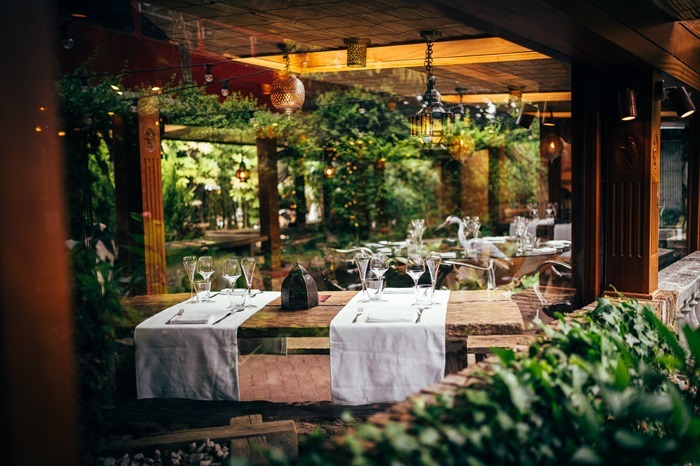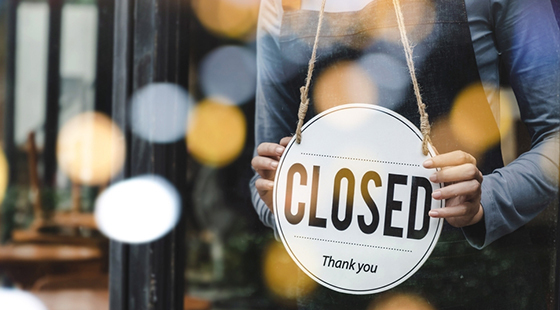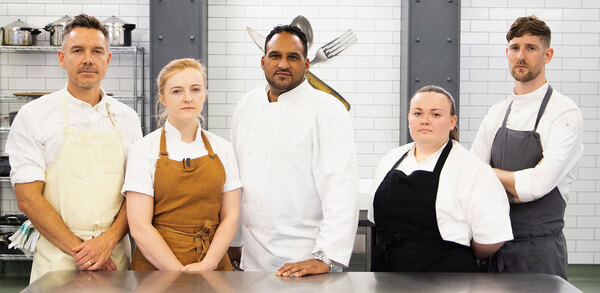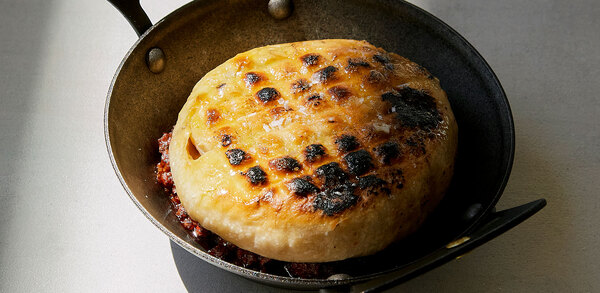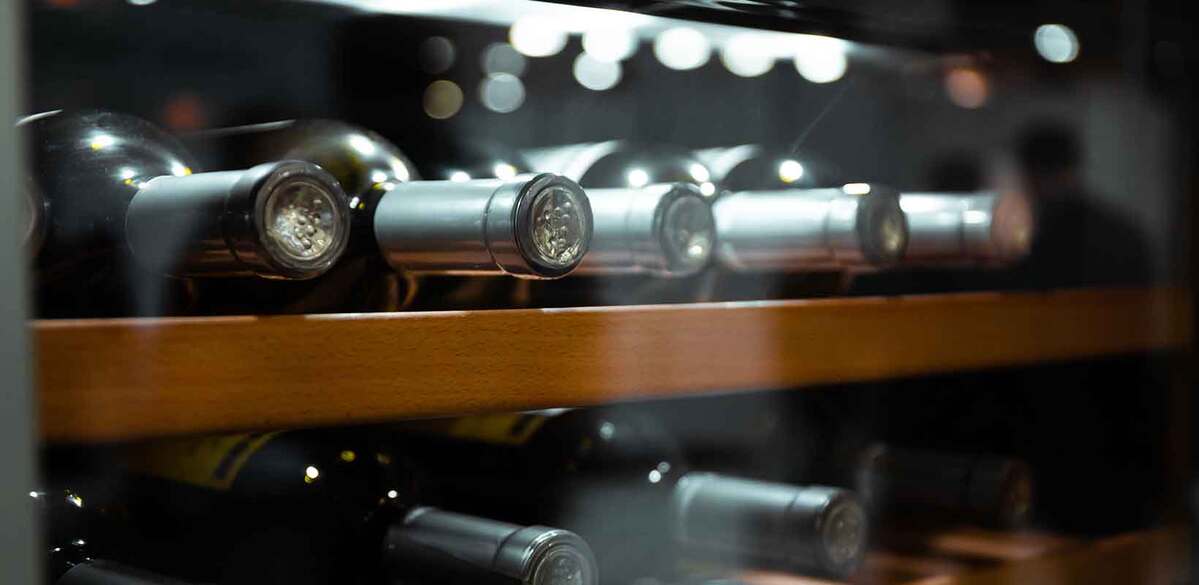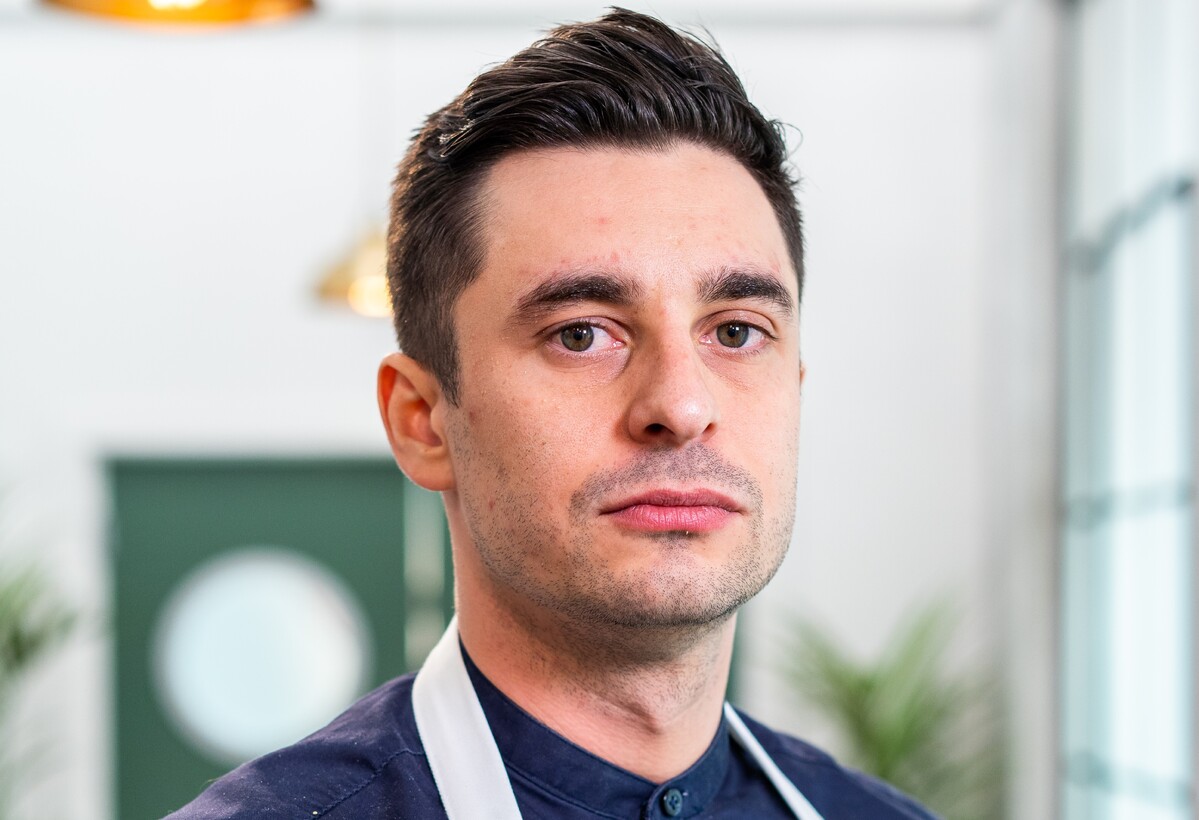Anna Hansen talks about her new opening The Modern Pantry
Anna Hansen, Peter Gordon's former partner at the Providores, has teamed up with D&D London to open her own restaurant in one of London's eating hubs. Fiona Sims reports on a venture that for so long looked doomed to failure
The Modern Pantry must be the most long-awaited restaurant opening in Britain - at least in terms of the time it has taken to come to fruition. It has been nearly four years in the making, and chef-owner Anna Hansen has suffered the loss of a backer due to illness, and tortuous planning negotiations to bring the place to market.
"One of the best moments of my life was seeing the name ‘the Modern Pantry' hand-painted in large gold letters, hanging over the entrance, at last," Hansen says.
It's on the only part of the building that is free of scaffolding. Just weeks before opening, the builders are scurrying to meet the deadline.
The Modern Pantry is in a Georgian-built townhouse and former steel foundry, Grade II-listed and located amidst advertising agencies and design firms, and in the heart of one of London's major eating hubs. There's St John restaurant near by, Zetter, Smiths of Smithfield, Clerkenwell Dining Room, Vinoteca and the Peasant gastropub. It's quite an array.
"I do have moments when I think, ‘Jesus Christ!' But people always want to experience something happy and fresh like we have here," Hansen says.
And the restaurant will be different, she insists. "I don't want to sound corny, but I use the modern pantry."
The 56-seat first-floor restaurant, due to open in September, will be accompanied by a 26-seat private dining room, a 40-seat ground floor café with 24 seats outside, and a small shop-cum-traiteur set for an 18 August launch date.
Hansen cuts a confident figure. She's 38, around 6ft, and looks remarkably fresh considering what she has gone through. Her site manager Tom calls to ask where to put an old set of metal weighing scales they found when stripping out the main room.
She picks up the phone: "They're classic old things, but really heavy. It would be nice to have them somewhere in the room, but I just can't think where at the moment," she ponders.
The robustness of the basic structure has been supplemented by a classic modern restaurant look: subdued grey walls, dark-stained wood floors, white wooden tables and chairs, and brown leather-covered banquette seating.
Raw copper lighting comes from Dutch designer Piet Hein Eek, plus Marcel Wanders' Sky Garden lighting for the upstairs restaurant, at £700 per light. The designers, Jump Design, usually fit out offices - this is their first restaurant project.
But Hansen has been making sure it isn't all hard edges. She has been sourcing antique glass candlesticks, plus old coffee pots and tea cups. "They'll be my personal stamp," she says.
Business degree
Hansen is one of the few top female chefs to have established herself on the restaurant scene in this country. Born in Canada and raised in New Zealand, she first came to London back in 1992, aged 22, after a degree in business management.
She found herself at a loose end, and so a friend persuaded her to join him in the kitchen at the French House Dining Room, then under Fergus and Margot Henderson. She worked as a kitchen porter, but was soon running the place when the bosses were away.
"The French Kitchen was an amazing experience," Hansen says. "There was no menu - it was, like, what are we going to cook today? That's what it's all about," she remembers.
Hansen was really fired up, which was a new experience. "My family are all very creative - except me. I felt like an outcast. But then suddenly I found that I could cook, and it was like something opening out for me."
She bumped into fellow Kiwi chef Peter Gordon while at the French House. He then employed her as sous chef at his first restaurant, Green Street, and the famous partnership would begin.
Later Gordon took Hansen on as pastry chef at the Sugar Club, in Soho, London, and the pair led the march of a new style of cooking popular in California, Sydney and Melbourne at the time, which had become known as fusion for its bringing together of apparently disparate ingredients.
Watermelon, feta cheese and pumpkin seed was one of the dishes made by Gordon at the Sugar Club at its first site in Notting Hill.
But just as quickly as fusion arrived, chefs lined up to slate it. It become known as ‘confusion' and the Sugar Club's owners, Ashley Sumner and Vivienne Hayman, converted it into a lower-priced restaurant. Gordon and Hansen left for the Providores in Marylebone, London, taking advantage of the tapas trend in the dining room downstairs, with more of an Asian slant in the room above.
After four years in the shadow of Peter Gordon, the man still turning out cook books and TV appearances, Hansen decided to go it alone. She came across a derelict building in Clerkenwell, London, and wandered in next door - to a branch of global communications network McCann Erickson. She asked whether it was for sale, and if so, could she buy the lease?
With the help of a backer and her own savings, Hansen tied up the deal, and then set about gaining planning permission - not easy considering the building's Grade II listing. Little did she know it would take four years.
Eighteen months down the line her backer pulled out because of illness. Eventually, the former Conran restaurants firm, now D&D London, came in for her. Chief executive Des Gunewardena, and project manager Sylfest Muldal are part of the new team.
Would it be hard without these two, a solo women leading the project? "At certain times I feel like I am being patronised, but that can work to my advantage - things happen for me. If men want to play that role, then I'm not going to stop them.
"In the past, people I've worked with have said things like ‘you're all right for a woman'. But I'm generally pretty laid back. I sometimes feel eerily devoid of emotion and tend to hum a lot when the shit hits the fan," she admits.
Women make up more than half the team at the Modern Pantry, which Hansen insists wasn't deliberate. "It just kind of happened that way. Though I have to say it is important for me to have women working for me. Women enjoy working with women."
Candi Giacchetti, her new manager, comes from the Zetter hotel opposite, while Elaine Murzi, her pastry chef, has been with Hansen from the start.
And that's the major positions filled - this is yet another new restaurant with no sommelier. Former Daily Telegraph columnist and chef Bill Knott has devised the 80-strong selection, with plenty from New Zealand, from six suppliers. "Even our fine dining will be casual," Hansen says.
As for the food, Hansen insists she is doing something new, too. "I'm trying to get away from fusion and Pacific Rim - it's a global thing," Hansen insists. "What does fusion mean? A fusion of what, exactly? Every cuisine is a fusion of something."
Wild mixtures?
Miso-marinated onglet with cassava chips and braised cherry tomatoes ticks the East-meets-West box, while smoked foie gras with caramelised rye crumbs, pickled rhubarb and buck sorrel is an unusual combination. But these are nothing like Peter Gordon's wild mixtures in the 1990s.
Hansen admits that she uses "crazy" ingredients. "The fact that I have pomegranate molasses is no different to balsamic vinegar from Italy," she says.
She's also opting for tamarind and assam - a fruit from Malaysia. "I love sour," she says. Dried shrimps, cassava and plantain (for chips and fritters) will also feature. But there's the more British-sounding "Homage to the Fish Fry-Up" - tempura shiso-battered oysters, grilled razor clams, parsley and garlic, mussel fritters. Or there's Hispanic octopus slow-cooked in its own juices, sambals and pickles.
The recent price hikes have affected dishes, with average spend in the upstairs dining room of £35 per head (without wine), rather than £30. She's kept prices in the downstairs café deliberately low, on the other hand, at up to £25 a head, providing plantain and coconut waffles with mango, blackberry and lime for breakfast, and sugar-cured prawn and spring onion omelette with dried shrimp sambal for lunch.
"This is without a doubt the scariest thing I've ever done," she says, before closing her laptop to check up once again on the dusty site.
The Modern Pantry, 47-48 St John's Square, Clerkenwell, London EC1V 4JJ
Anna hansen's CV
- August/September 2008 the Modern Pantry opens
- 2005 Leaves the Providores to focus on developing the Modern Pantry
- 2001 Opens the Providores in Marylebone, London, with Peter Gordon (Hansen also acted as consultant chef to New York restaurant Public)
- 1998 Moves with Peter Gordon to the Sugar Club, Soho
- 1997 Sets up her first London catering business, The Cooker
- 1994 Joins Peter Gordon at Green Street restaurant
- 1992 Works under Fergus Henderson at his first restaurant venture, the French House
Hansen has also worked extensively in New Zealand and in Australia.
Earl Grey panna cotta with Maury jelly
For the jelly (Serves six)
600ml Maury wine
3 gelatine leaves
Sugar to taste
Soak the gelatine leaves in cold water for a minute or so to soften them. Bring the wine up to a boil and remove from the heat. Squeeze out the gelatine leaves to remove as much water as possible and whisk in to the wine. Allow to cool and pour 100ml into the bottom of the dariole moulds. Cover and refrigerate. While the jelly is setting, make the panna cotta.
To make the panna cotta (Serves six)
400ml milk
300ml cream
55g sugar
1 heaped teaspoon Earl Grey leaves
3 gelatine leaves
Bring the milk, cream and sugar to the boil in a pot. Remove from the heat and mix in the tea leaves. Leave to infuse for five minutes or so until you have a delicious Earl Grey flavour. Strain and whisk in the gelatine leaves (softened as for the jelly). Leave to cool then strain once more through a fine sieve.
Once the jelly has set and the panna cotta mix is cold, pour half-a-cup of the panna cotta mix on top of the jelly. Cover and refrigerate for two to three hours or until the panna cotta has set. The length of setting time will depend on how cold your fridge is.
To serve, hold the moulds under the hot water tap for a couple of seconds to loosen. Place the mould upside-down on a plate and gently shake until the panna cotta slips out. Serve with brandy snaps or other biscuits.



